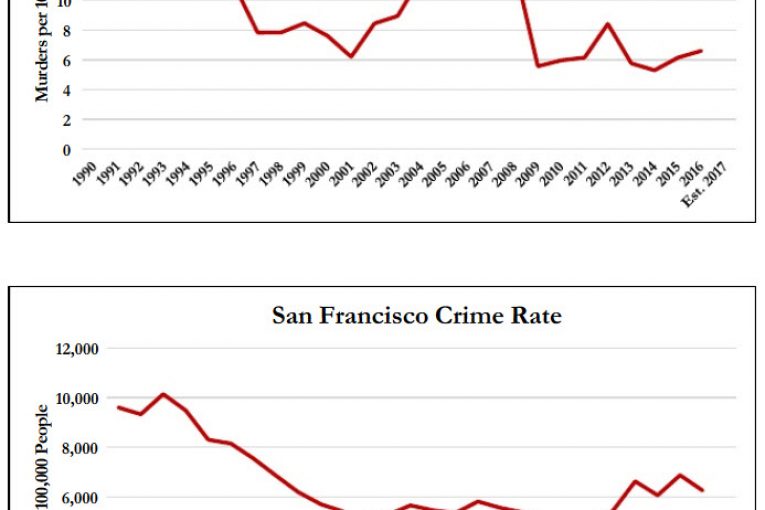

By Alex Jimenez
SAN FRANCISCO, CA – While public perception would describe San Francisco as crime ridden and unsafe, data shows a downward trend in violent crimes during the pandemic while property crimes continue to be a major issue, suggesting the crime data does not clearly show a trend indicating worsening public safety.
Statistics compiled by the San Francisco Chronicle of crime data and trends in San Francisco show it’s complex and at times unclear, but many San Franciscans feel that crime is getting worse.
This sentiment has political implications—SF District Attorney Chesa Boudin could be removed from office this June in a recall election because many residents blame his policies as being too lenient to criminals.
The San Francisco Chronicle analyzed police incident reports comparing 2022 crimes rates with the first quarters of the past four years, which note police data may not accurately measure crime since only reported crimes can be measured. Still, the information provides useful data in tracking crime trends. 
According to Magnus Lofstrom, a senior researcher at the Public Policy Institute of California, the data indicates a dramatic shift in crime during the pandemic but appears to be returning to pre-pandemic conditions, a pattern also observed statewide.
“We have certainly seen fluctuations during the pandemic, but I think we’re roughly back to where we were before the pandemic started,” Lofstrom told The Chronicle.
Last year a team of researchers including crime economic researcher Jennifer Doleaf released a preliminary research paper looking at 35 jurisdictions which elected “reform minded prosecutors” such as Boudin. The study analyzed whether these reform policies, i.e. reducing cash bail and increasing pre-trial diversion, had an effect on crime.
“If those prosecutors’ reforms affect local crime rates, then we should see a change in crime trends relative to trends in other places, beginning soon after the prosecutors took office,” the authors wrote.
But, they later added, “We do not find statistically significant effects on any type of crime.”
Violent crimes such as rapes, robberies and assaults are lower than they were in 2018, although murder and shooting rates have gone up. Cities across the country have experienced a more dramatic increase in murders compared to San Francisco, according to FBI analytics.
Burglaries which spiked during the pandemic are trending downwards, returning to pre-pandemic levels. Some have said that in San Francisco many residents left the city, opening the door for potential burglaries, and now residents are returning to the city post pandemic.
Motor vehicle theft remains high, a phenomenon also experienced in other cities, which Lofstrom attributes to the increased value of used cars, stating “the value of used cars has ballooned, making the prospect of stealing a vehicle more enticing.”
Statistics also show larceny theft, specifically car break ins and bike theft—which declined significantly in 2020 and 2021 due to fewer people in the streets during the pandemic—however, are rising slightly as people return to the streets.
The exception is shoplifting, which continues to spike considerably above pre-pandemic levels in 2022 and is continuing to rise since last year.
The Chronicle article considers that the numbers may not fully represent shoplifting in the city overall because an increase in reported shoplifting at a single location inflated this statistic, taking away the reported burglaries from that single target and the numbers are comparable to 2018.
Researchers note that while property crime rates have declined during the pandemic, the rates have spiked since 2011 and have remained steady for the decade. San Francisco has the second highest rate for property crimes in California behind Oakland. Per 10,000 residents there are 443 instances of such crimes in San Francisco, 513 in Oakland, 235 in San Jose and 220 in Los Angeles, respectively.
Many researchers, such as Lofstrom, theorize that high levels of economic inequality exhibited in San Francisco contribute to the city’s high number of property crimes, where inequality was exacerbated during the pandemic.
“When we have these increases in disparity, (wealthy neighborhoods), become increasingly good targets,” Lofstrom previously told The Chronicle.
Many residents blame DA Boudin for changes in crime rates, but according to Lofstrom, “There is no credible research pointing to a relationship between DAs and broader measures of public safety, such as crime rates.”






